Speech ‘Australia – Ten Reasons for Confidence’
Australia, like other countries, has a number of economic problems. Too often the media focuses on the negatives, and downplays the good progress which, I believe, is being made on several fronts.
Today I want to suggest ten reasons for confidence about Australia's future – both in sustaining the nascent recovery, and in meeting the challenges of a competitive world. These reasons reflect changes wrought over the past decade – changes which are often not appreciated, and which are (and need to be) on-going.
1. Recovery is Underway
It is clear that steady, if unspectacular, economic recovery is underway in Australia. Over the past two years, real GDP has grown by about 5 per cent, with the main contributions coming from consumer and government spending, and from housing (see Graph 1).
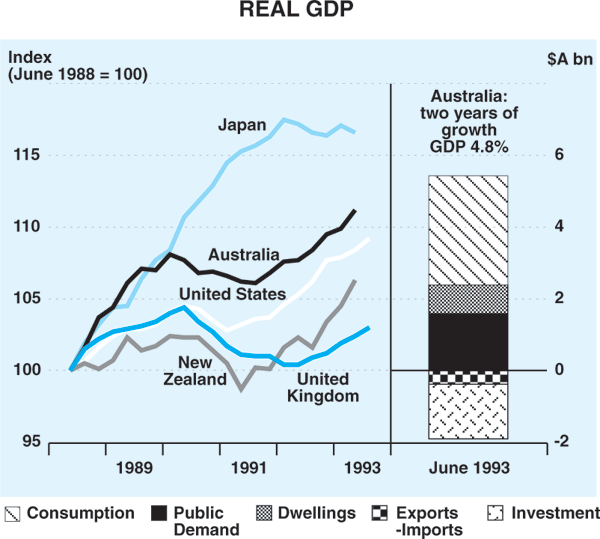
The economy is currently growing at an annual rate of about 3 per cent. This compares favourably with most OECD countries but Australia needs to grow faster, on a sustained basis, to wind back unemployment.
That faster growth is attainable but it requires a number of things to happen, including pick-ups in the world economy and business investment, and on-going economic policies which build on past measures to boost national savings and international competitiveness.
2. The World Economy will Recover
The immediate outlook is bleak in parts but the world economy will recover eventually. The United States is exhibiting a stronger tone but Germany and Japan are six to twelve months away from showing any significant growth. As a group, the industrial countries are forecast to grow by a little over 2 per cent in 1994; this suggests a very modest improvement compared with the past three years when growth averaged 1 per cent.
As the developed countries pick up, commodity prices can be expected to recover also, notwithstanding the current over-supply of certain commodities. This connection between growth in industrial countries and commodity prices is well understood – it is one of the main mechanisms through which events in the industrial world have an impact on Australia.
What is less well understood is the connection between Australia and the newly industrialising countries of Asia. These countries now account for almost 35 per cent of Australia's exports, compared with little more than 10 per cent 20 years ago (see Graph 2). Over the same period, the share of total exports represented by European countries has declined from 20 per cent to 12 per cent. (The share of foreign investment in Australia attributable to European countries has also declined sharply – from around 40 per cent in 1980 to around 25 per cent at present.)
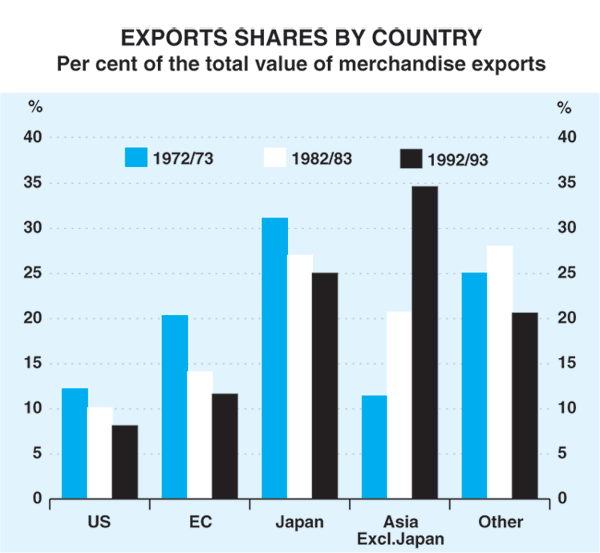
The strong performances of many Asian economies have lifted the growth rate in Australia's major trading partners a good percentage point above that for the OECD group of countries over recent years. Although some slowing in China appears inevitable in the near term, the extra impetus to Australia's exports from sustained, rapid growth in this region should continue.
3. The Scene is Set for a Recovery in Business Investment
The prospects for that other necessary ingredient for faster growth – business investment – are also improving. Reflecting the cash flow benefits of lower interest rates and cost cutting programs, company profits are now comparable with the levels reached prior to the strong surge in investment in the second half of the 1980s.
To date, the improved cash flows and increased equity raisings have been directed mainly towards restructuring balance sheets and reducing corporate gearing. This process now appears to have largely run its course and, with more businesses operating profitably and confidence gradually returning, the focus is switching to plans to increase spending on plant and equipment (see Graph 3).

Credit to the business sector has not grown during the past 2½ years but the banks generally are now better placed to respond to demands for credit when they emerge. Their profitability has been improved by cost cutting measures and by a steady decline in non-performing loans and new provisions for bad loans. Their capital positions are strong, with the average capital ratio for all banks approaching 11 per cent at the end of June, well above the 8 per cent minimum (see Graph 4).
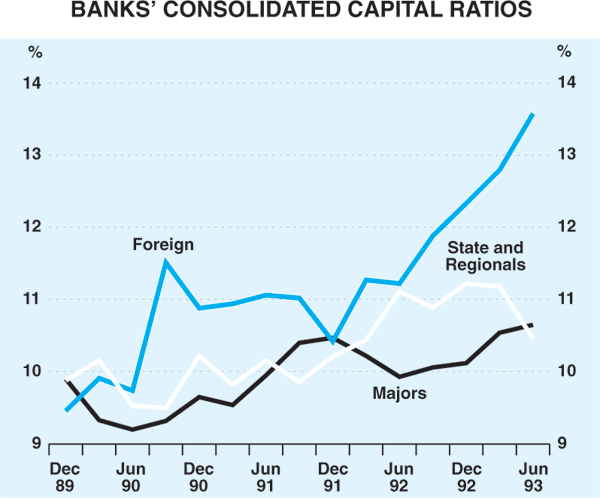
Confidence is quite important for business investors. They need to be confident that increased output can be sold. They need to be confident also that economic policy will remain broadly on track.
Uncertainties of the kind raised recently over aspects of the budget, Mabo and new industrial relations legislation will arise from time to time. These do affect adversely perceptions about Australia.
As much as businesses might like to put them to one side, and get on with the main game, that is difficult when real or perceived changes in the rules of the game are involved. Such concerns, however, are likely to be assuaged to the extent that policy ‘fundamentals’ are on the right track – and expected to stay there. Fortunately, the ‘fundamentals’ generally are on track, which augurs well for the future.
4. Inflation is Under Control and will Remain So
Chief among these is our lower rate of inflation. Australia is into its third year of ‘underlying’ inflation of around 2 per cent – the best performance since the early 1960s, and one of the best in the world (see Graph 5).

The ‘headline’ or published rate is expected to rise a little over coming quarters as increases in government taxes and charges show up, along with the impact of the depreciation of the $A on prices of imported goods. But, provided these effects are contained, and second-round increases in prices and wages are avoided, the ‘underlying’ rate of inflation can be held around 2 to 3 per cent.
Our confidence on this issue reflects several factors:
- the ‘authorities’ (meaning the Government and the central bank) are determined to hang on to low inflation;
- our greater integration into the world economy, particularly Asia, together with on-going reductions in tariffs, will exert powerful international competitive pressure on domestic prices and wages; and
- largely reflecting these pressures, attitudes are changing with, for example, greater emphasis on increases in productivity, and greater acceptance of lower future inflation in price and wage setting behaviour.
Wage increases have been quite moderate now for many years (see Graph 6). This has made an important contribution to lowering inflation. That contribution needs to continue, through even closer linkages to productivity and further attention to freeing up restrictive work and management practices. Rigid positions by one or more parties result in larger job losses in firms having to cut costs to survive than would be necessary if the parties were more flexible.

As the recovery gathers momentum, there will be a natural desire for workers to share in the better profits. That is a legitimate aspiration, and negotiated increases based around continuing improvements in productivity and workplace flexibility provide a mechanism for both paying higher wages and containing costs.
In this way, growth can be kept going for longer, absorbing more of the unemployed (including the long term unemployed) and generating more wealth. That situation is obviously to be preferred to a reversion to the bitterness and confrontation of the past, which is counterproductive for all – bringing a fall in profits, employment and, ultimately, incomes.
The containment of labour costs and lower industrial disputation reflected in Graph 6 are both well kept secrets, which are counter to many of the stereotypes about Australia. These trends provide a basis for confidence about the future.
5. Low Inflation has meant Lower Interest Rates
The decline in inflation and inflationary expectations over recent years has allowed nominal interest rates to fall to historically low levels (see Graph 7). Since early 1990, short-term interest rates (the ones determined by the authorities) have declined from 18 per cent to under 5 per cent.
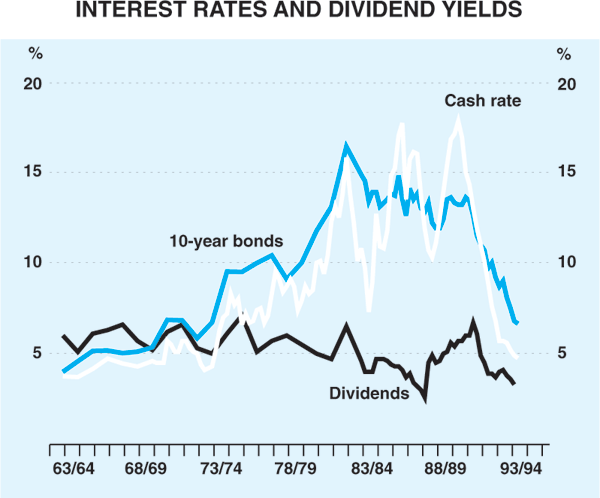
In ‘real’ terms, short and long-term interest rates in Australia are currently in about the middle of the range of OECD countries (see Graph 8).
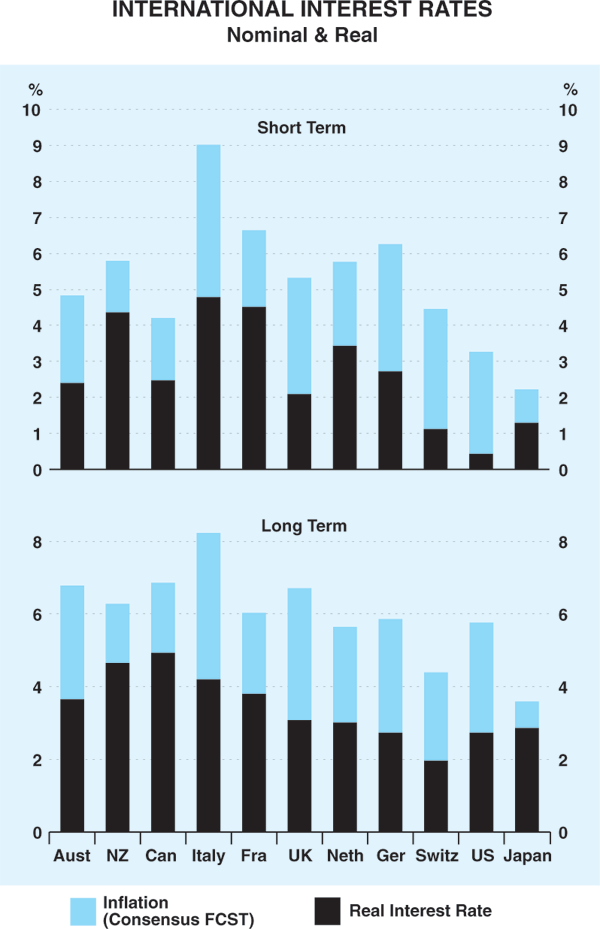
As well as improving the cash flows of both households and businesses, lower interest rates have led to some portfolio adjustments, with the stock market being the main beneficiary. Share prices have risen by over one-third so far in 1993.
Lower rates of inflation also need to be taken into account when evaluating rates of return and payback benchmarks for investment projects. Some companies appear to be evaluating investment opportunities using criteria more appropriate to the high inflation era of the 1970s and 1980s than the present. In that era, short payback periods, and assets whose capital values appreciated quickly (such as property), were the order of the day. Today, longer-term investment in genuinely productive areas is more competitive and we can expect to see more of it as the changed inflation outlook is factored into investment decisions.
6. Productivity is Growing
A sixth reason for being confident about Australia's economic future is that labour productivity is growing again, after pausing in the second half of the 1980s (see Graph 9). Indeed, allowing for strong productivity gains in several areas such as finance and the public sector – where low or zero productivity growth is effectively assumed – the true picture is probably even better than the graph suggests.
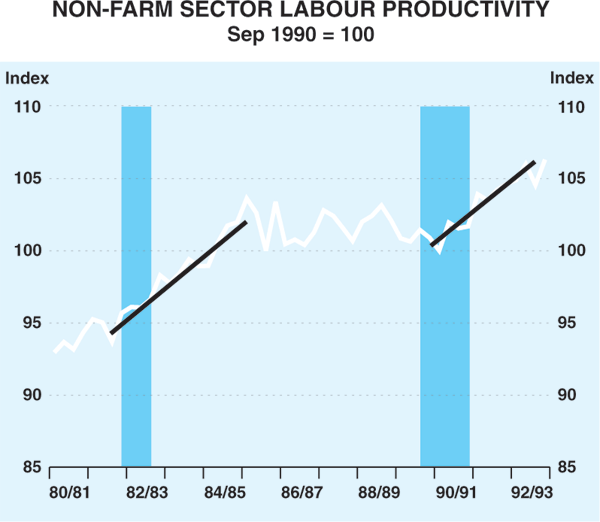
This productivity growth is helping to moderate labour costs, and to maintain low inflation and export competitiveness. Over the longer run, rising productivity means rising standards of living.
Further improvements can be made. I mentioned earlier how genuine enterprise bargaining over work conditions can help to raise private sector productivity. In the government sector too there is scope to use the capital stock more effectively by reducing overmanning and removing monopoly privileges. This is now happening in several areas, including electricity generation, airlines, telecommunications, banking and infrastructure development.
7. Government Debt is a Lesser Burden than in Many Other Countries
It is another well kept secret, but the ratio of government debt to GDP in Australia is one of the lowest in the world (see Graph 10).
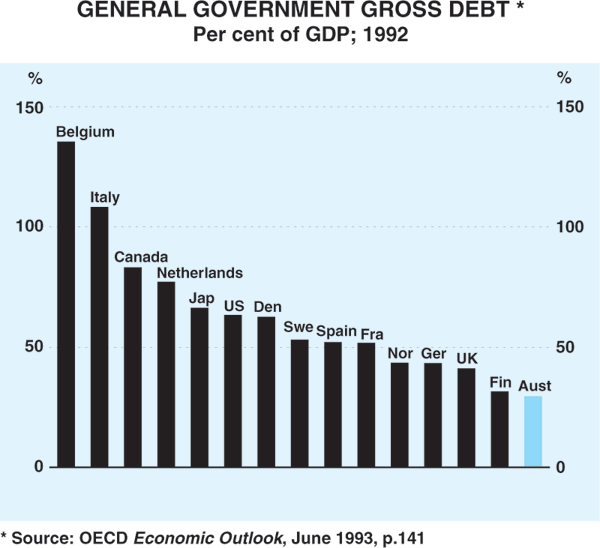
Australia's good showing in this graph, which covers all levels of government, owes much to the four successive years of budget surpluses recorded by the Commonwealth Government in the late 1980s. It explains why Australia has had more room than most countries for some fiscal manoeuvering – that is, room to allow, responsibly, the budget deficit to run up in the past couple of years to assist economic recovery.
The government debt ratio is rising again because of anti-cyclical fiscal measures in Australia (and many other countries). Maintaining our good position requires that budget deficits at all levels of government be wound back as the recovery proceeds.
8. The Budget Deficit will be Reduced
That is why the passage of the latest Commonwealth budget was very important. That budget provided, for the first time, a package of measures to reduce the deficit over the medium term – from close to 4 per cent of GDP in 1992/93 and 1993/94 to around 1 per cent by 1996/97 (see Graph 11). The specific measures proposed to achieve that result – and, indeed, the appropriateness of the 1 per cent deficit target for 1996/97 and its underlying assumptions – can be debated but few would question the need to substantially wind back the deficit as the economy picks up.
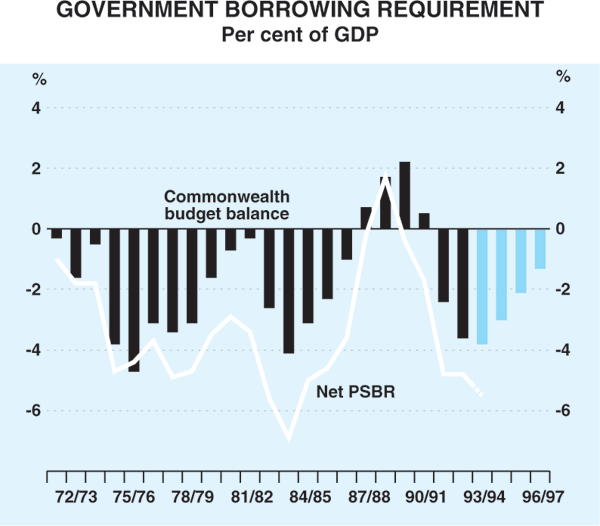
Reducing the budget deficit is the quickest and surest way to achieve a significant improvement in our national savings. This, in turn, will help to reduce our heavy call on foreign savings which has been reflected in large current account deficits and rising foreign debt.
9. We are Making Progress on the Current Account Deficit
This is my ninth reason why we should have confidence in Australia's economic future.
In simple terms, the best way for Australia to grow faster and escape the external constraints of large current account deficits and rising foreign debt is through increased exports. Resources are now being shifted to the export sector, encouraged by our proximity to the rapidly growing countries of Asia.
The composition of our exports also is changing. Rural and resource based exports still dominate, but exports of elaborately transformed manufactures and services (notably tourism) have grown rapidly in recent years (Graph 12). On conventional measures (which include manufactures that are not elaborately transformed), manufactures comprise a bigger share of exports than rural products.

What is not generally recognised is that these adjustments have been underway for several years and are now having a discernible impact on the current account. The trend improvement in the trade balance since the early 1980s is evident in Graph 13. In trend terms, the current account deficit has stabilised over this period, following the trend increase during the 1970s and early 1980s. These adjustments will need to be pursued to further lower the current account deficit.
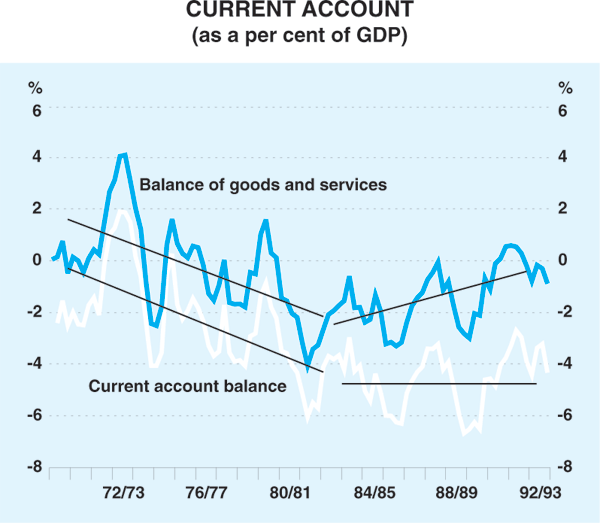
The problem with large on-going current account deficits is that they keep adding up our foreign debt. Australia's net foreign debt stands at about 43 per cent of GDP, which is comparable with, for example, Canada and well below that of New Zealand. The private sector accounts for 63 per cent of Australia's foreign debt, with government businesses accounting for another 16 per cent; the general government sector accounts for only a relatively small part (20 per cent).
The level of foreign debt does matter but it should be kept in perspective. Debt has to be serviced and we would be vulnerable if, because of shocks of one kind or another, servicing threatened to become an unmanageable burden. It has not in the past. In fact, while foreign debt has continued to accumulate, our ability to service that debt has improved over recent years. Aided mainly by falling interest rates at home and abroad, debt service payments as a proportion of export income have fallen from 21 per cent in 1989/90 to 12 per cent in 1992/93.
10. We Are Very Competitive Internationally
This is my tenth reason. That we are now very competitive has to be a major plus for the future. Sustained low inflation and on-going productivity gains will help to hold the competitive edge conferred by the 20 per cent fall in the exchange rate over the past two years.
In real terms, our exchange rate is low by historical standards (see Graph 14), and the recent gains are unlikely to be frittered away by renewed domestic inflation. Unit labour costs in Australia are 30 to 40 per cent lower, relative to our key trading partners, than they were a decade ago, and 50 per cent lower than at the worst point in the mid 1970s.
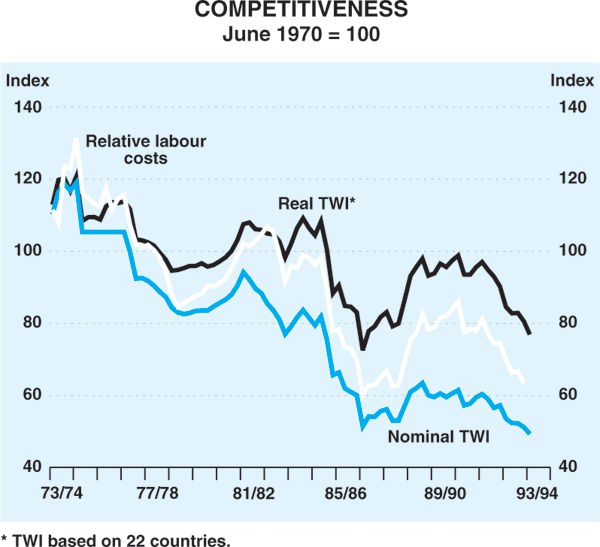
Conclusion
I have talked today mainly about facts and specific data that could be illustrated with a graph. I conclude with a more nebulous idea – that the most important change, and the most important reason for optimism about Australia, is an attitudinal shift. No longer do manufacturers, for example, look to tariff protection to shelter them from overseas competition or domestic cost pressures. No longer do Australian workers assume that they can achieve wage levels without regard for overseas conditions and competition. Employers and employees are coming to grips with the reality of competing in international markets and, to do this, ‘world best practice’ is becoming the watchword.
The attitudinal change is not total, nor has it always been translated fully into practice. But the transformation is well underway and there is no notion of turning back. Despite a sharp downturn and protracted recovery, the longer term measures to create a more competitive economy have continued unabated. Australians are ready to step forward and meet the challenge of greater internationalisation – they are understanding that in the short term it is painful, but in the longer term essential.
